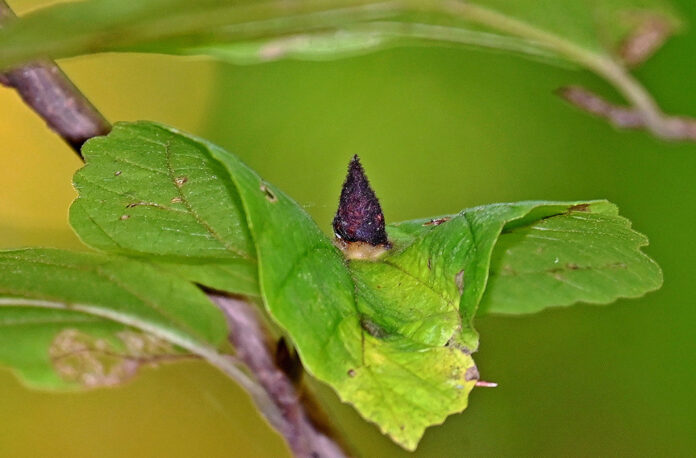Naturalists have a unique sense of humor — one which only naturalists understand. When I worked at the park, I was often the first one in the office. These early hours were dictated by the research projects I was conducting, often in association with birds.
One morning, as I sat at my desk, readying my paperwork for the day, something smacked the wall behind me, and ricocheted past my ear. I looked up. WHAT was that? I looked around. No one was present. I went back to my notes. A few minutes later, it happened again…twice! I stood up and began to check inside all the cubicles for the hidden prankster that was throwing things at me while I worked. The place was empty.
As I returned to my desk, I noticed a small, shiny-black seed lying next to my notes. I picked it up and examined it more closely as a smile spread across my face. Now I knew what I was looking for and I quickly found them. Hidden strategically around my desk area were the seed pods of the witch hazel bush. That morning, they had dried just enough to open and eject their contents. Mission accomplished for whoever concealed them there!

Identifying it
Established throughout much of the eastern U.S., American witch hazel (Hamamelis virginiana), is a small, deciduous tree that is most often found growing in the understory, beneath the forest canopy. Shrublike in appearance due to the numerous stems that originate from its base, shade-loving witch hazel rarely attains heights of more than 20 feet and can easily equal that in width. Its leaves are broad and simple, up to 6 inches in length and bordered by smooth, wavy teeth around the margins. In autumn, the dark green leaves turn a brilliant yellow, tattling on the plants’ locations in the forest.
There is a tiny gall wasp that lays its eggs in the leaves of witch hazel. As I mentioned in my August article on oak apple galls, a gall is an abnormal growth found on a plant, caused by eating or egg-laying activity of an insect. When a gall wasp deposits an egg, it injects hormones that aid in the creation of the gall structure itself by altering the leaf’s typical growth pattern. Slowly, the affected section of leaf begins to grow, aberrantly, around the egg, getting larger as the leaf matures. The size and shape of the gall is indicative of the species that created it. It just so happens that the galls found on the leaves of witch hazel are conical and pointy, very much resembling that of a witch’s hat.
Medicinal properties
Many recognize the name witch hazel, not for the plant that it is, but as a name on a bottle they see on store shelves. Witch hazel has long been recognized for its medicinal attributes. It has been harvested for hundreds of years because of its anti-inflammatory properties in treating bruising. As an astringent, it is also useful in treating insect bites as well as minor cuts and scrapes. In fact, it is the only plant-based, non-prescription drug approved by the FDA.

Late bloomer
I don’t think much about witch hazel most of the year, but when autumn rolls around, it moves itself to the forefront and steals the show. You see, unlike most trees that unfurl their blossoms in the spring, witch hazel saves its flowers for the grand finale. It is our latest flowering native tree.
Beginning in early October, the witch hazel suddenly bursts into bloom and is in full splendor by Halloween. The flowers are unique, each one sporting four lemon-yellow petals less than an inch in length. Twisted and slender, these flowers are often thought to resemble the long, gnarly fingers of a witch. With a little imagination, they can also be viewed as little golden spiders dancing in the branches. Once all of the leaves exit the trees, these vivid flowers are all that remain to brighten the dampened landscape, often hanging on throughout the winter.
Witch hazel flowers are extremely fragrant, often catching one’s olfactory attention while strolling through the woods. That being said, they are an extremely important target for some of the later insects. A small species of moth in the owlet family emerges from dormancy to feed on the flowers throughout the winter, designating it as the primary pollinator of the tree.
Once pollinated, small greenish capsules develop, each one harboring two, shiny-black seeds. These will remain on the plant until the following winter. As they dry, the capsules take on a woody texture and begin to slowly split open. Finally, the day comes when a mechanism within the structure erupts, sending the seeds flying with incredible force. Seeds ejected from the pods have been found a whopping 40 feet from the tree, allowing them to land out from beneath the shade of the mother plant. Seeds must lie in the duff for two whole years before they can achieve germination.
Oh, I got even with my co-worker who strategically placed those witch hazel pods around my desk, resulting in a barrage of catapulting seeds. I won’t be telling you about my retaliation though. It’s humor only a naturalist would understand!













